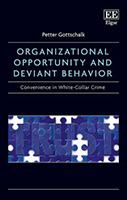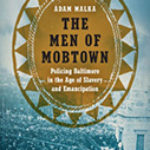Organizational Opportunity And Deviant Behavior: Convenience in White-Collar Crime

Author: Petter Gottschalk
Publisher: Cheltenham, UK; Northampton, MA: Edward Elgar Publishing, 2017. 256p.
Reviewers: Viviana I. Vasiu and Ellen S. Podgor | July 2019
White collar crime has its roots as a sociological concept from Edwin Sutherland’s 1939 speech to the American Sociological Society. But although not categorized as such until then, it was prominent in criminal law. Throughout the years, many have offered sociological, psychological, and legal perspectives on its cause and methods for eradication. Petter Gotschalk provides a new and innovative way of approaching this discipline in his work, Organizational Opportunity and Deviant Behavior.
The new dimension offered here is premised on “convenience theory,” a theory emanating from exactly the term used – convenience. Gottschalk notes the complexity of this term in illuminating the reader on how it is used in other spheres, such as marketing literature. Here, one finds distinctions made “between economical convenience, organizational convenience, and behavioral convenience.” He uses this architecture for evaluating white-collar crime, but also notes how convenience can drive white-collar crime when opportunity, rationalization, and legitimacy are entangled with the desire to accomplish goals with the least amount of resources.
Gottschalk presents the use of convenience theory premised on an economical, organizational, and behavioral framework for explaining white-collar crime. In the economical dimension section, Gottschalk applies Maslow’s hierarchy of needs psychological theory to shed light on the distinct motivations between street and white-collar crime. While street crimes can be used to satisfy bottom needs such as food and safety, white-collar crimes tend to be used to keep from falling off the top of the hierarchy or to continue ascending, such as by satisfying needs of prestige and feelings of accomplishment. The economical dimension shows to readers that the motivation is, pure and simple, financial gain. The author insightfully points out how the quest for money is often based on that motivation and if the law gets in the way, alternative, oftentimes illegitimate means are employed because it is convenient. White-collar criminals also tend to more frequently engage in rationally weighing options than street criminals—white collar crimes are the consequences of choosing convenient choices in the face of rigid laws, bureaucracy, and regulations.
Gottschalk then focuses on the second dimension within convenience theory: organizational dimension. The structure of a corporation allows for committing and concealing crimes, thus emphasizing an opportunity venue. Gottschalk again uses street crime to distinguish white-collar crime in providing a better understanding of why it occurs: unlike street criminals, white-collar criminals have legitimate access to the resources and venues used to carry their criminal activities, are displaced from victims, and their acts have an appearance of legitimacy. The organizational dimension to white-collar crime is represented by the crime scene that is the corporation. Thus, Gottschalk explains that this provides employees, especially CEO’s at the top of the hierarchy, with a crime opportunity. When opportunities decrease or disappear, so does white-collar criminal activity. Gottschalk then provides readers with an answer to why there are so few female white-collar offenders through the organizational dimension: there are much fewer women in positions of power and key decision-making in corporations and thus less opportunities for committing white-collar crime.
The last dimension discussed is the behavioral dimension. In this section, Gottschalk uses neutralization theory and how this dimension emphasizes the willingness to commit this type of crime. Neutralization techniques are frequently employed by white-collar criminals and include damage and victim denial. Rationalizing their deviant actions is a coping mechanism that both enables white-collar crime and helps neutralize its consequences in the minds of the perpetrators. Gottschalk notes that white-collar criminals will rationalize their actions in multiple ways by, for instance, telling themselves and others that their actions were acceptable or necessary in their position at that time. Unlike the plethora of research and materials out there on the positive qualities of leaders, Gottschalk does not shy away from unveiling the negative sides through the theory of dark sides of leadership. Narcissism, hubris, social dominance, and even Machiavellianism are mentioned as the dark traits that leaders can possess. This type of position attracts people who possess those traits as these organizational leadership positions grant a legitimate way to receive the power and attention they crave.
Gottschalk transitions from a theoretical sphere to vividly proving this theory through a wealth of evidence such as autobiographies, interviews, court records, and internal investigations from Norway and the United States. These are particularly useful in walking readers through the trilogy of dimensions, individually and interrelated. Gottschalk adds to the credibility of his approach by explaining why certain types of evidence and data are more superior to others in proving convenience theory in white-collar crime. For example, Gottschalk warns readers of the danger in interviewing white-collar criminals because of their tendency to victimize and skew answers. Nevertheless, interviews from other sources can be particularly useful and, to that effect, Gottschalk includes an unbiased source of interviews from students who had not been exposed to convenience theory in white-collar crime.
Among the plethora of examples and data used, readers can find quotes and samples from autobiographical books written by famous white-collar criminals, such as Bernard Kerik, that directly support a variable in convenience theory: neutralization techniques. Numerous case studies of white-collar criminals are then used through the prism of the trilogy of dimensions. For instance, Gottschalk portrays Frank Murud’s economic dimension through his greed and love of material wealth—he did not mind jail time, losing his wife, or the negative publicity, but was saddened that his material valuables had been seized. Murud’s organizational dimension is exemplified through the ease with which he could send illegal invoices to the accounting department and take advantage of the structure of the corporation. Finally, Murud’s behavioral dimension is supported by his blaming game, rationalization, and assessment of risks and rewards.
Moreover, a study of an elicitation of student opinions is included to show further support for this theory. Numerous hypotheses from the first major section are tested, such as the economical dimension hypothesis analyzing increased desire for convenient profit being positively related to increased tendency to commit white-collar crime. The study ultimately shows that the theory and hypotheses underlying it are sound, with the strongest hypothesis being the influence of willingness in the behavioral dimension on the opportunity in the organizational dimension.
Gottschalk also includes a discussion on whistleblowers. White-collar crime is much harder to detect, due to the organizational dimension and legitimacy appearance—hence, the importance of whistleblowers. The fear of retaliation or lack of proof can lead many whistleblowers to give leads to journalists instead of reporting within the corporation. Furthermore, the author includes a section on corporate social responsibility and how white-collar crime is the antithesis of it. Despite the belief stemming from the neutralization effect in white-collar criminal minds that their crimes are victimless, shareholders, banks, owners, borrowers, society at large can all be victims, sometimes in high amounts. Gottschalk argues how, regardless of other organizational efforts, corporate social responsibility is not achieved if white-collar crimes are not kept under control by corporations.
Finally, Gottschalk wraps up this fascinating journey for readers by including a sample of United States investigation reports. These reports are on famous white-collar crimes committed by organizations such as Enron, General Motors, Lehman Brothers, Motorola, and WorldCom. These reports support the organizational dimension to show the opportunities lying within these corporations that allow for white-collar crime to occur.
Gottschalk’s book supports what could be called the rather than equation: rather than X (losing material enrichment/power or not climbing further towards it), Y will be chosen (usually an illegitimate alternative that is convenient and translates to a white-collar crime). The author persuasively demonstrates the overarching theme of his book: that increased inconvenience of responding in legal ways under financial incentives and pressures and increased convenience of responding in illegal ways to financial incentives and pressures leads to a greater risk of white-collar criminal behavior. In the end, the author proposes that white-collar crime must be made less convenient by establishing more severe criminal consequences, increasing early detection, and identifying the higher-ups that are in the sweetest spot to turn to convenient alternatives.
Gottschalk provides an important component in the study of white-collar criminality. One wonders whether some of his thoughts can be incorporated into corporate compliance programs that are aimed towards detecting and reducing criminality. One also wonders whether deliberate convenience versus negligent convenience on the part of a corporation should factor into the sentencing analysis. What is particularly inspiring by this work is that it looks at white-collar crime proactively as opposed to reactively, something that legal scholars sometimes fail to do. In this regard, this book’s use of convenience theory provides a new landscape for evaluating this criminality.
Viviana I. Vasiu is a Federal Judicial Clerk for the U.S. District Court for the Middle District of Florida.
Ellen S. Podgor is the Gary R. Trombley White Collar Crime Family Research Professor & Professor of Law at Stetson University College of Law.


